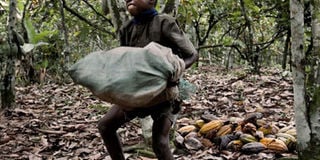Prime
48% of Bugisu children engaged in child labour – report

Many children in Uganda are engaged in domestic service, stone quarrying, brick-making and laying, construction, sand and clay mining, commercial agriculture, charcoal burning, hotels and bars, hunting and commercial fishing, and in the informal sector, and car washing among others
What you need to know:
They sell maize and use the proceeds to take care of needs at their home, which is headed by their grandmother in Bugema ‘B’ Bungokho Sub-county, Mbale District
Seven-year-old Juliet Kakai and her six-year-old sister, Scovia Mutonyi, carry buckets on their heads filled with boiled maize wrapped in polythene bags to Mbale City every afternoon.
They sell maize and use the proceeds to take care of needs at their home, which is headed by their grandmother in Bugema ‘B’ Bungokho Sub-county, Mbale District.
“Our grandmother starts preparing the maize every morning and later in the afternoon after school, we carry it to town to sell,” Kakai says.
Another minor, Phylis Namono, dropped out of school in Primary Two and now vends yellow bananas, “and other things that bring in money because doing business and schooling had become difficult.”
The children are among the 48 percent children engaged in child labour in Bugisu Sub-region, according to research carried out by the AfriChild Centre in partnership with Terre Des Hommes Nethrlands with support from the Global Fund to End Modern Slavery (GFEMS).
The research was conducted between May and November 2022 and 1,871 children from 771 households were involved in the study.
While presenting findings to stakeholders at Pretoria Hotel in Mbale City at the weekend, Mr Alex Alinaitwe, the research coordinator of AfriChild Centre, said child labour has increased among the minors aged between five and 11 years in the region.
“The boys constituting 51 per cent were more exploited than their female counterparts (42 per cent),” he said.
The report findings show that four in 10 children (43 percent) aged 5-17 years were engaged in hazardous work, including the use of sharp tools, working long hours, exposure to agro-chemicals and carrying heavy loads.
“The decision for children to engage in such laborious activities is often made by their parents, who also benefit financially from their children’s work,” Mr Alinaitwe, said.
The report identifies poverty as the primary driver of child labour, along with the demand for cheap labour byemployers.
Mr Alinaitwe said only 25 percent of children in hazardous child labour reported using any personal protective equipment (PPE).
The findings also revealed that Kapchorwa District registered high child labour in the coffee chain with 65 percent, Bududa had 50 percent while Sironko had 35 percent and Mbale 30 percent.
“The boys more than girls participated in more physically demanding activities such as spraying, pruning, carrying, loading and off-loading coffee,” he said.
Mr Isaac Daniel Munaaba, the programme coordinator at TdH Netherlands, said eastern Uganda has a higher prevalence of child labour compared to western Uganda, where a previous study reported a 30 percent rate.
“Financial and material poverty and also difficulties in accessing education were identified as the key drivers of child labour in this region,” he said.
The Elgon regional police spokesperson, Mr Rogers Taitika, attributed the increasing defilement and rape cases in the region to child labour.
“Many female children have been raped and defiled while going back home because they work until late,” Mr Taitika said.
Mr James Kutosi, the Mbale City Council spokesperson, said the local governments are not well facilitated to enforce child labour law.





